Tom Hosking
Command A: An Enterprise-Ready Large Language Model
Apr 01, 2025



Abstract:In this report we describe the development of Command A, a powerful large language model purpose-built to excel at real-world enterprise use cases. Command A is an agent-optimised and multilingual-capable model, with support for 23 languages of global business, and a novel hybrid architecture balancing efficiency with top of the range performance. It offers best-in-class Retrieval Augmented Generation (RAG) capabilities with grounding and tool use to automate sophisticated business processes. These abilities are achieved through a decentralised training approach, including self-refinement algorithms and model merging techniques. We also include results for Command R7B which shares capability and architectural similarities to Command A. Weights for both models have been released for research purposes. This technical report details our original training pipeline and presents an extensive evaluation of our models across a suite of enterprise-relevant tasks and public benchmarks, demonstrating excellent performance and efficiency.
If You Can't Use Them, Recycle Them: Optimizing Merging at Scale Mitigates Performance Tradeoffs
Dec 05, 2024
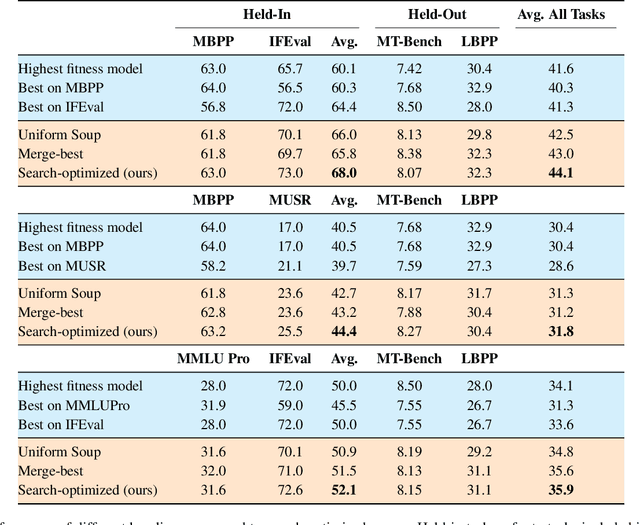
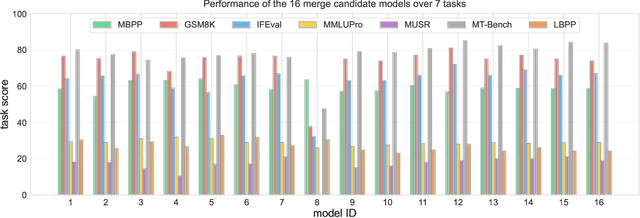
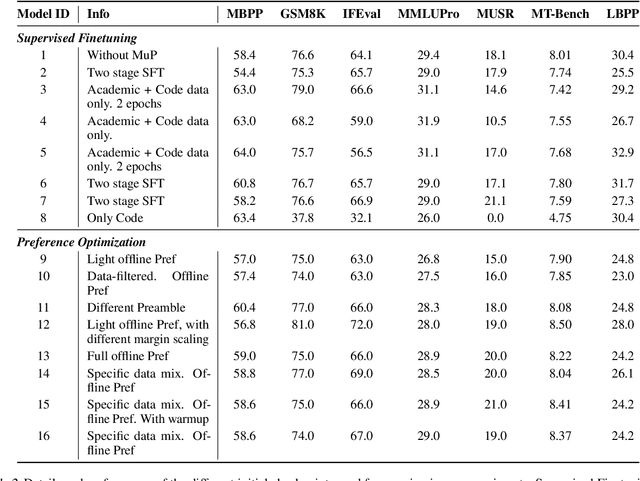
Abstract:Model merging has shown great promise at combining expert models, but the benefit of merging is unclear when merging ``generalist'' models trained on many tasks. We explore merging in the context of large ($\sim100$B) models, by \textit{recycling} checkpoints that exhibit tradeoffs among different tasks. Such checkpoints are often created in the process of developing a frontier model, and many suboptimal ones are usually discarded. Given a pool of model checkpoints obtained from different training runs (e.g., different stages, objectives, hyperparameters, and data mixtures), which naturally show tradeoffs across different language capabilities (e.g., instruction following vs. code generation), we investigate whether merging can recycle such suboptimal models into a Pareto-optimal one. Our optimization algorithm tunes the weight of each checkpoint in a linear combination, resulting in a Pareto-optimal models that outperforms both individual models and merge-based baselines. Further analysis shows that good merges tend to include almost all checkpoints with with non-zero weights, indicating that even seemingly bad initial checkpoints can contribute to good final merges.
Hierarchical Indexing for Retrieval-Augmented Opinion Summarization
Mar 01, 2024Abstract:We propose a method for unsupervised abstractive opinion summarization, that combines the attributability and scalability of extractive approaches with the coherence and fluency of Large Language Models (LLMs). Our method, HIRO, learns an index structure that maps sentences to a path through a semantically organized discrete hierarchy. At inference time, we populate the index and use it to identify and retrieve clusters of sentences containing popular opinions from input reviews. Then, we use a pretrained LLM to generate a readable summary that is grounded in these extracted evidential clusters. The modularity of our approach allows us to evaluate its efficacy at each stage. We show that HIRO learns an encoding space that is more semantically structured than prior work, and generates summaries that are more representative of the opinions in the input reviews. Human evaluation confirms that HIRO generates more coherent, detailed and accurate summaries that are significantly preferred by annotators compared to prior work.
Human Feedback is not Gold Standard
Sep 28, 2023



Abstract:Human feedback has become the de facto standard for evaluating the performance of Large Language Models, and is increasingly being used as a training objective. However, it is not clear which properties of a generated output this single `preference' score captures. We hypothesise that preference scores are subjective and open to undesirable biases. We critically analyse the use of human feedback for both training and evaluation, to verify whether it fully captures a range of crucial error criteria. We find that while preference scores have fairly good coverage, they under-represent important aspects like factuality. We further hypothesise that both preference scores and error annotation may be affected by confounders, and leverage instruction-tuned models to generate outputs that vary along two possible confounding dimensions: assertiveness and complexity. We find that the assertiveness of an output skews the perceived rate of factuality errors, indicating that human annotations are not a fully reliable evaluation metric or training objective. Finally, we offer preliminary evidence that using human feedback as a training objective disproportionately increases the assertiveness of model outputs. We encourage future work to carefully consider whether preference scores are well aligned with the desired objective.
Optimal Transport Posterior Alignment for Cross-lingual Semantic Parsing
Jul 09, 2023Abstract:Cross-lingual semantic parsing transfers parsing capability from a high-resource language (e.g., English) to low-resource languages with scarce training data. Previous work has primarily considered silver-standard data augmentation or zero-shot methods, however, exploiting few-shot gold data is comparatively unexplored. We propose a new approach to cross-lingual semantic parsing by explicitly minimizing cross-lingual divergence between probabilistic latent variables using Optimal Transport. We demonstrate how this direct guidance improves parsing from natural languages using fewer examples and less training. We evaluate our method on two datasets, MTOP and MultiATIS++SQL, establishing state-of-the-art results under a few-shot cross-lingual regime. Ablation studies further reveal that our method improves performance even without parallel input translations. In addition, we show that our model better captures cross-lingual structure in the latent space to improve semantic representation similarity.
Attributable and Scalable Opinion Summarization
May 19, 2023



Abstract:We propose a method for unsupervised opinion summarization that encodes sentences from customer reviews into a hierarchical discrete latent space, then identifies common opinions based on the frequency of their encodings. We are able to generate both abstractive summaries by decoding these frequent encodings, and extractive summaries by selecting the sentences assigned to the same frequent encodings. Our method is attributable, because the model identifies sentences used to generate the summary as part of the summarization process. It scales easily to many hundreds of input reviews, because aggregation is performed in the latent space rather than over long sequences of tokens. We also demonstrate that our appraoch enables a degree of control, generating aspect-specific summaries by restricting the model to parts of the encoding space that correspond to desired aspects (e.g., location or food). Automatic and human evaluation on two datasets from different domains demonstrates that our method generates summaries that are more informative than prior work and better grounded in the input reviews.
Hierarchical Sketch Induction for Paraphrase Generation
Mar 21, 2022



Abstract:We propose a generative model of paraphrase generation, that encourages syntactic diversity by conditioning on an explicit syntactic sketch. We introduce Hierarchical Refinement Quantized Variational Autoencoders (HRQ-VAE), a method for learning decompositions of dense encodings as a sequence of discrete latent variables that make iterative refinements of increasing granularity. This hierarchy of codes is learned through end-to-end training, and represents fine-to-coarse grained information about the input. We use HRQ-VAE to encode the syntactic form of an input sentence as a path through the hierarchy, allowing us to more easily predict syntactic sketches at test time. Extensive experiments, including a human evaluation, confirm that HRQ-VAE learns a hierarchical representation of the input space, and generates paraphrases of higher quality than previous systems.
Factorising Meaning and Form for Intent-Preserving Paraphrasing
May 31, 2021



Abstract:We propose a method for generating paraphrases of English questions that retain the original intent but use a different surface form. Our model combines a careful choice of training objective with a principled information bottleneck, to induce a latent encoding space that disentangles meaning and form. We train an encoder-decoder model to reconstruct a question from a paraphrase with the same meaning and an exemplar with the same surface form, leading to separated encoding spaces. We use a Vector-Quantized Variational Autoencoder to represent the surface form as a set of discrete latent variables, allowing us to use a classifier to select a different surface form at test time. Crucially, our method does not require access to an external source of target exemplars. Extensive experiments and a human evaluation show that we are able to generate paraphrases with a better tradeoff between semantic preservation and syntactic novelty compared to previous methods.
Querent Intent in Multi-Sentence Questions
Oct 18, 2020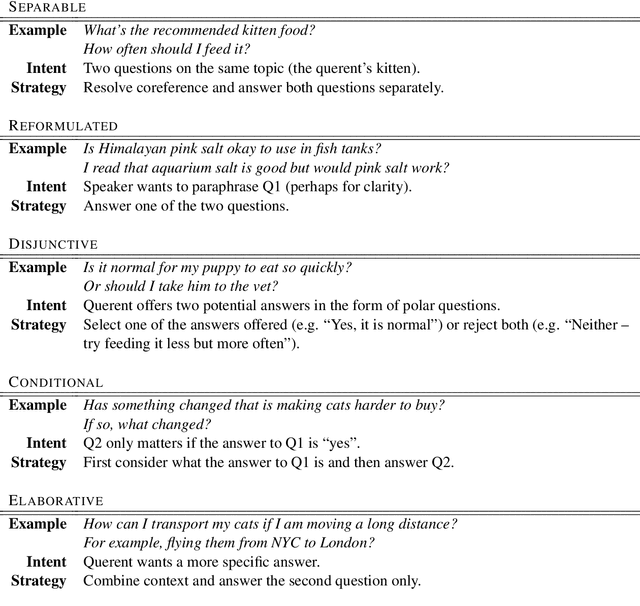
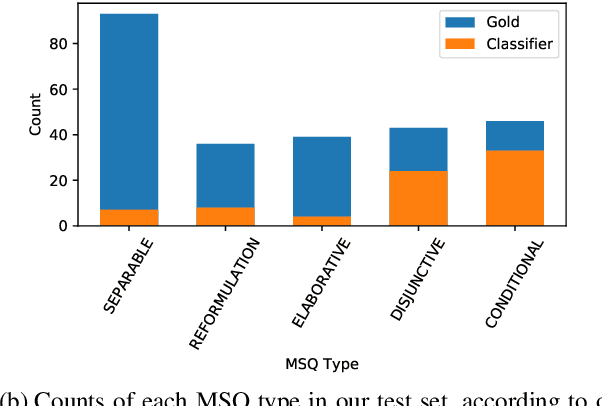
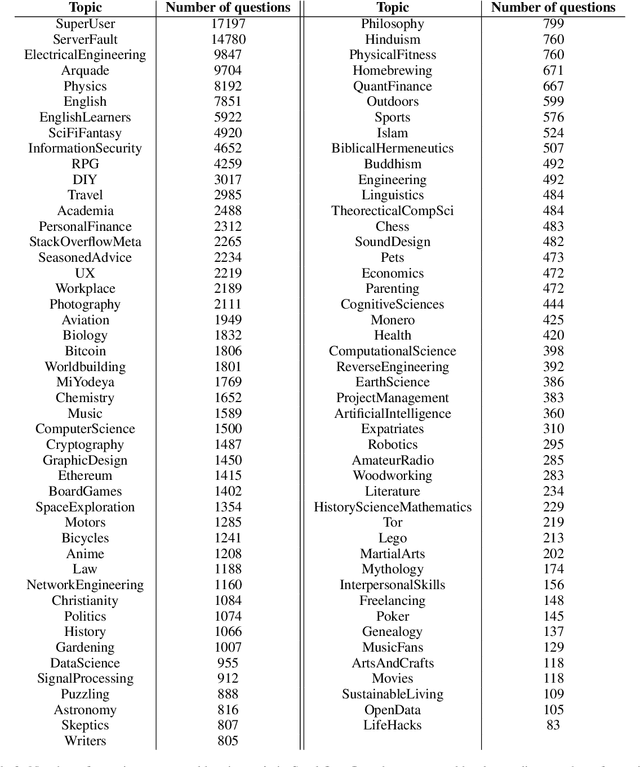

Abstract:Multi-sentence questions (MSQs) are sequences of questions connected by relations which, unlike sequences of standalone questions, need to be answered as a unit. Following Rhetorical Structure Theory (RST), we recognise that different "question discourse relations" between the subparts of MSQs reflect different speaker intents, and consequently elicit different answering strategies. Correctly identifying these relations is therefore a crucial step in automatically answering MSQs. We identify five different types of MSQs in English, and define five novel relations to describe them. We extract over 162,000 MSQs from Stack Exchange to enable future research. Finally, we implement a high-precision baseline classifier based on surface features.
Evaluating Rewards for Question Generation Models
Feb 28, 2019



Abstract:Recent approaches to question generation have used modifications to a Seq2Seq architecture inspired by advances in machine translation. Models are trained using teacher forcing to optimise only the one-step-ahead prediction. However, at test time, the model is asked to generate a whole sequence, causing errors to propagate through the generation process (exposure bias). A number of authors have proposed countering this bias by optimising for a reward that is less tightly coupled to the training data, using reinforcement learning. We optimise directly for quality metrics, including a novel approach using a discriminator learned directly from the training data. We confirm that policy gradient methods can be used to decouple training from the ground truth, leading to increases in the metrics used as rewards. We perform a human evaluation, and show that although these metrics have previously been assumed to be good proxies for question quality, they are poorly aligned with human judgement and the model simply learns to exploit the weaknesses of the reward source.
 Add to Chrome
Add to Chrome Add to Firefox
Add to Firefox Add to Edge
Add to Edge